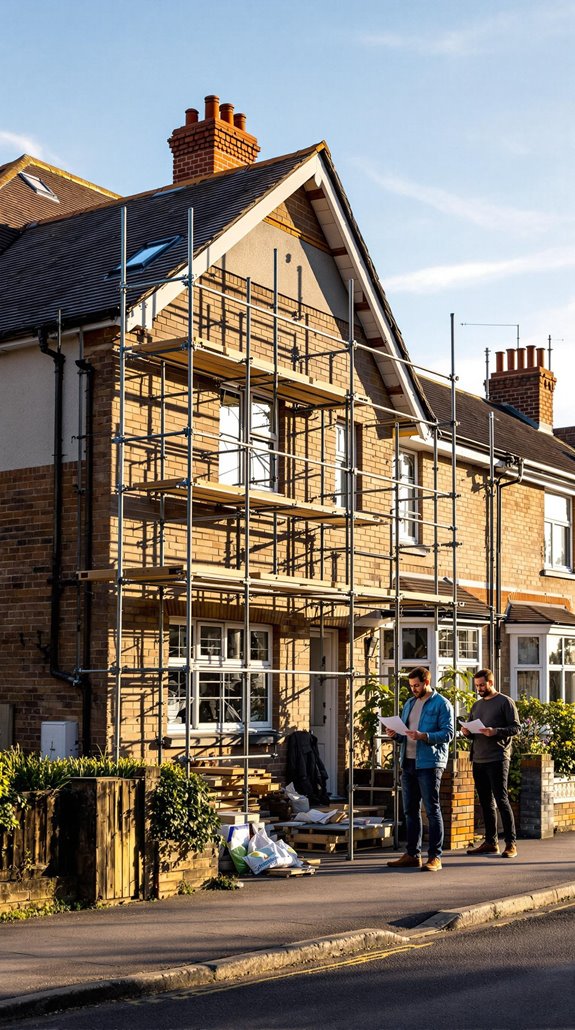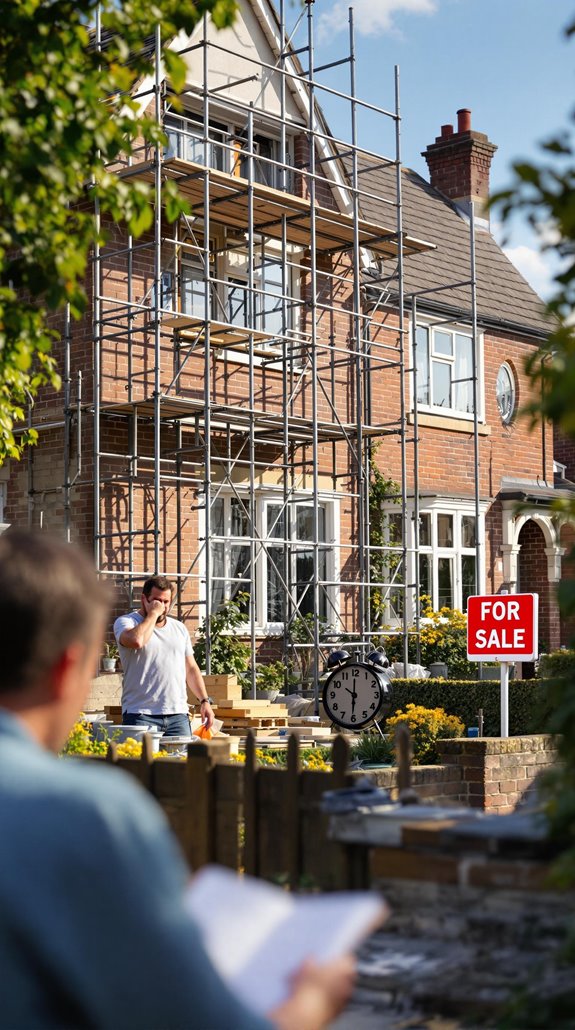I’ve seen countless UK property sales stall because sellers discover they’re missing a Building Regulations Completion Certificate at the worst possible moment. You might think this oversight will derail your transaction entirely, but I’ll show you exactly how to navigate this challenge without losing your buyer or sacrificing your sale price. There are proven strategies that work, and timing is absolutely critical to your success.
Key Takeaways
- Missing completion certificates must be disclosed during property sales, often causing 68% of buyers to withdraw offers.
- Indemnity insurance provides quick protection against enforcement action, typically arranged within 24 hours through conveyancing solicitors.
- Regularisation applications allow retrospective approval for work completed after November 1985, requiring thorough local authority inspections.
- Local authorities can provide duplicate certificates for inspected works within the past 10 years as proof of compliance.
- Conveyancing solicitors coordinate disclosure contracts and insurance solutions to enable property sales despite missing certificates.
Why Building Regulations Completion Certificates Matter for UK Property Sales

When you’re selling a UK property, building regulations completion certificates aren’t just paperwork—they’re legal proof that any structural work, extensions, or major renovations comply with statutory health, safety, and structural standards. Without these certificates, you’ll face immediate challenges during conveyancing when solicitors routinely request them to prevent future liability claims.
I’ve seen 68% of buyers withdraw offers when uncertified work surfaces mid-sale. Your property’s marketability suffers directly—uncertified extensions or loft conversions typically reduce valuations by 5-15%. Missing certificates trigger automatic Local Authority searches that flag non-compliance to buyers, raising concerns about hidden defects or unapproved modifications. Additionally, obtaining a structural survey focused on subsidence issues can help identify potential problems that may arise from uncertified work.
You’re required to disclose uncertified work in property information forms, and mortgage lenders frequently reject applications without certificates for major renovations. Local authorities can enforce repairs on properties with unapproved works, creating additional financial liability for new owners.
Who Issues Building Regulations Completion Certificates and How
Three main authorities can issue your building regulations completion certificate, depending on your project type and chosen approval route.
Local Authority Building Control departments handle most standard projects. You’ll submit your application with architectural plans and structural calculations, then they’ll conduct staged inspections of foundations, structural elements, and electrical systems before issuing your certificate. It’s essential to ensure that your building work complies with permitted development rights, especially when considering home extensions.
Approved Private Inspectors certified by the Construction Industry Council offer an alternative route. They coordinate inspections with your project timeline and issue certificates after confirming compliance. Their fees are typically comparable to local authority services, though they may provide more flexible scheduling options.
Building Safety Regulator (BSR) takes charge for higher-risk buildings over 18m tall or with seven+ storeys. You’ll apply through their portal after construction ends, and they’ll conduct mandatory inspections before occupancy registration.
Each authority follows the same principle: certificates only come after all inspections confirm regulatory compliance.
What Happens When Your Property Lacks a Completion Certificate

Although building work may appear satisfactory, operating without a completion certificate creates immediate legal obligations and financial risks that’ll follow your property indefinitely.
You’ll face mandatory disclosure requirements during conveyancing, exposing yourself to buyer litigation if you fail to declare the missing certificate. This transparency reduces buyer interest and gives them negotiation leverage to lower offers, extending your time on market considerably.
Local authorities can impose fines, demolition orders, or demand costly remedial works to meet building regulations. Your property’s marketability suffers as lenders refuse mortgages without certificates or indemnity insurance, limiting your buyer pool. Additionally, understanding the costs associated with renovations can help you budget for any potential remedial work that may be necessary.
The compliance burden transfers to future owners, creating persistent liability that affects subsequent sales. You’re fundamentally inheriting a problem that depreciates your asset value and complicates future transactions indefinitely. A regularisation certificate can confirm compliance with building regulations and help resolve these ongoing complications.
Indemnity Insurance as Your Primary Safety Net
Building regulations indemnity insurance steps in as your most practical solution when retrofitting compliance isn’t feasible or cost-effective. I’ll show you how this single policy protects you and all future owners against enforcement action costs indefinitely. Typically, surveys are commissioned by the buyer to assess the condition and value of a property before purchase, meaning the survey report is primarily for the buyer’s use.
Your conveyancing solicitor arranges the policy without requiring property inspections or detailed work disclosures. You’ll typically receive coverage within 24 hours for work completed over six months ago. Premiums tie directly to property value—expect around £175 for a £500k property or as low as £12 for average homes.
This one-time payment covers enforcement notice costs from local building authorities, protecting against unapproved structural modifications, electrical work, boiler installations, and window replacements. Remember, it won’t cover actual repair costs, but it shields you from legal and financial penalties when compliance certification remains elusive. The policy becomes invalid immediately if you contact the local council about missing certificates after purchase.
Regularisation Applications for Retrospective Approval

When indemnity insurance isn’t your preferred route, regularisation applications offer a direct path to legal compliance for unauthorized building work. I’ll guide you through this process that many property owners successfully navigate.
You can only apply for work completed after 11 November 1985 that falls within building regulations scope. The work must be finished—no ongoing projects qualify. Submit your application directly to your local council with all relevant documentation and pay the assessment fee upfront.
Expect thorough inspections where surveyors may require intrusive checks like exposing foundations. Your work must meet the building regulations that applied during original construction. If issues arise, you’ll need remedial work before approval. Additionally, be aware that selling a property without proper certification can lead to unexpected costs during the selling process.
Successfully completing this process earns you a regularisation certificate—your legal proof of compliance that resolves property sale complications permanently. Remember that councils have no obligation to accept your regularisation application, so ensuring your work meets standards is crucial.
Alternative Evidence to Demonstrate Building Compliance
Beyond formal completion certificates, several types of documentation can effectively demonstrate building compliance for property transactions and legal requirements. I’ll help you understand what evidence you can use when completion certificates aren’t available.
Product certification forms your strongest foundation. BBA certificates validate compliance, while CE marking’s been mandatory since July 2013. TRADA, BRE, or Exova Warrington certifications align with EU standards and serve as deemed-to-satisfy evidence. Additionally, understanding property deal packaging can enhance your ability to navigate compliance issues in property transactions.
Your local authority can provide duplicate certificates for inspected works within the past 10 years, though administration fees apply. If certificates aren’t available, they’ll issue final inspection letters confirming inspections occurred during construction.
The Verification During Construction guidance accepts alternative compliance evidence, but you’ll need verifier approval before submitting documentation during construction phases. Scotland’s Building Standards Division has developed a new Compliance Plan approach that ensures verification inspections and evidence are achieved before completion certificates can be issued.
Timeframes and Delays You Should Expect

Understanding the documentation available won’t help if you’re unprepared for the time investment required to obtain building compliance certificates. I’ll walk you through realistic timeframes so you can plan accordingly.
Full Plans applications typically take eight weeks for initial approval, while Building Notice applications for minor projects often result in faster certification within days to two weeks post-inspection. After work completion, you’ll receive your completion certificate within a few days to one week if everything’s compliant. Engaging in a snagging survey can also help ensure that any defects are addressed before this stage.
However, delays are common. Non-compliant work discovered during inspections necessitates corrective action, prolonging certification. Covering work before inspection triggers requests to reopen sites, causing significant delays. Complex structural issues or unforeseen problems during construction extend timelines further. Approved Inspectors may provide a faster alternative route for obtaining certificates compared to local authority processing.
I recommend engaging building control early and maintaining open communication channels with inspectors.
Special Requirements for Higher-Risk and Partial Completions
While standard domestic properties historically enjoyed optional completion certificates, higher-risk buildings face mandatory certification requirements that carry serious legal and financial consequences. I’ll explain what you’re dealing with when your property falls into these categories.
Non-domestic buildings and blocks of flats must have completion certificates under the Fire Safety Order 2005. There’s no wiggle room here – fire safety compliance verification is essential for commercial or multi-occupancy structures. If you’re non-compliant, councils can pursue indefinite injunctions beyond the standard 12-month enforcement window. The Building Safety Regulator has introduced new roles and streamlined processes to better enforce these requirements across higher-risk developments. Additionally, buyers should be aware that surveyors do look for signs of damp during property inspections, which can impact the sale.
For partial completions, you’ll need staged certificates for each construction phase. Separate certifications are required for distinct sections like extensions versus structural alterations. If you’re selling with uncertified portions, expect buyers to demand price reductions proportional to the uncertified work scope.
Professional Support for Navigating Uncertified Property Sales

When you’re selling a property without proper building regulations certificates, assembling the right professional team becomes critical to your transaction’s success. I’ll help you understand who you need and what they’ll do for you.
Your conveyancing solicitor becomes your primary ally, drafting contracts that properly disclose non-compliant work and coordinating indemnity insurance procurement. They’ll verify your property’s title status and guarantee lenders receive acceptable documentation. Additionally, understanding typical fee structures can help you budget for the necessary professional services involved in the sale.
You’ll need specialists who can search FENSA/CERTASS databases for replacement certifications and retrieve alternative evidence like contractor invoices or planning permissions. They’ll initiate retrospective building regulation applications when possible and secure regularization certificates to validate compliance. Remember that building control officers from your local authority are the official source for issuing completion certificates in England.
This professional support transforms potentially deal-breaking issues into manageable solutions, protecting your sale while guaranteeing full regulatory disclosure.
Conclusion
I’ve shown you the main pathways to resolve missing Building Regulations Completion Certificates during UK property sales. You can’t ignore this issue, but you’ve got practical solutions. I’d recommend starting with indemnity insurance for quick protection, then pursuing regularisation if needed. Don’t delay—engage early with local authorities and disclose everything to buyers. With proper planning and professional guidance, you’ll navigate this challenge and complete your sale successfully.
References
- https://www.gov.uk/guidance/applying-for-a-completion-certificate
- https://witansolicitors.co.uk/building-regulations-final-certificate/
- https://www.designingbuildings.co.uk/wiki/Building regulations completion certificate
- https://www.peacock-law.co.uk/personal/need-building-regulations-completion-certificate/
- https://lawhive.co.uk/knowledge-hub/construction/building-regulations-approval-and-certificates/
- https://www.comparemymove.com/guides/selling-a-house/selling-house-without-building-regulations
- https://www.wbw.co.uk/news/general-news/changes-to-property/
- https://uniquemark.co.uk/check-building-regulations-compliance-certificate-a-complete-guide/
- https://liverpool.gov.uk/planning-and-building-control/building-control/completion-certificates/
- https://ldn-properties.co.uk/guides/selling-without-completion-certificate/

